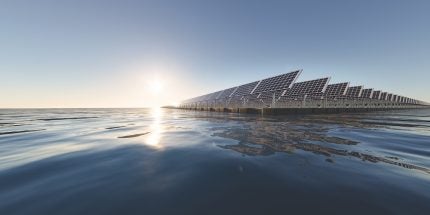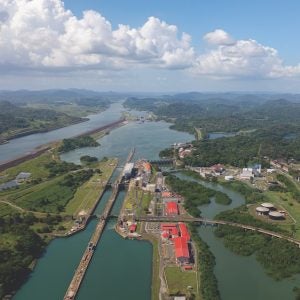
In the face of climate change, the growth of solar photovoltaics has consistently exceeded all projections, and is predicted to be the dominant renewable energy source by 2050. However, with increasing land-use pressures and the expense of building-mounted photovoltaics, water surfaces are now increasingly being exploited to host these technologies.
The rapid growth of solar energy has been attributed to its cost effectiveness and global nature, along with is flexibility in deployment. These advantages have also driven rapid deployment of floating solar photovoltaics (FPVs) around the world in recent years, particularly on artificial water bodies. Such growth is anticipated to continue, capitalising on the estimated 5M km2 of Earth’s surface area covered by lakes and reservoirs.
To date though, as recent research by Woolway et al states, a lack of understanding about the global potential of FPVs has meant there isn’t sufficient insight to guide future deployment. However, as new research from the team from the universities of Bangor and Lancaster in the UK, and their Chinese colleagues estimate, there’s 14,906TWh of potential for floating solar photovoltaics on over one million water bodies worldwide. And with a conservative 10% surface area coverage, floating solar photovoltaics could produce sufficient energy to contribute an average 16% of some countries’ electricity demands.
Selecting appropriate locations for floating solar
As the researchers caution though, there are several factors that must be considered when selecting appropriate locations for floating solar projects. The key constraints for a water body include:
- It is located within 10km of a population centre.
- It is not situated within a protected area.
- The duration of ice cover is less than six months.
- The water body has not dried up during the study period.
After selecting sites considered suitable to host FPVs based on these constraints, 94% of the water bodies studies by Woolway et al were deemed unsuitable according to their criteria. This left 67,893 water bodies remaining in the researchers’ global dataset, with a total estimated annual power output of 1302TWh across them.
A considerable fraction of the global power output from FPV would be generated from water bodies located within specific countries, including large ones such as China (252 TWh), Brazil (170 TWh) and the US (153 TWh). However, some comparatively smaller countries can also produce a considerable amount of electricity from FPV. The example was given of Papua New Guinea which with 19 TWh was the country with the 12th largest estimated total power output from FPV within the study. Not only is it located near the equator where solar irradiance is high but it is also home to some large water bodies, such as Lake Murray (647km2) and Lake Kutubu (49km2 )
Woolway et al also estimate that if all of the feasible water bodies have 10% of their surface area covered by FPVs (up to 30km2), 3% of countries considered in their study could meet their energy demands. Some countries such as Bolivia with FPV production of 9TWh almost meets its energy demands (11 TWh in 2021), while others such as Ethiopia can generate 129% of electricity demand from FPV. As this analysis suggests, the countries with the greatest total power output from FPVs are typically those with the greatest electricity demand.
Crucially, Woolway et al add, FPV could also increase access to electricity to communities in some nations. For example, in Chad or Malawi, where the installation of FPVs in selected water bodies could contribute substantially to national electricity demand (73% and 29%, respectively); approximately one-tenth of the population of these countries do not have access to electricity.
The global deployment of FPVs could also lead to a total annual reduction of 0.45 billion tonnes of CO2 but there are also unknown impacts of FPVs on water body carbon cycling, plus their knock-on effect on things such as CO2 emissions from water bodies.
However, FPV technologies do have the potential to reduce water scarcity. Water loss via evaporation is accelerating globally under climate change and it is thought that FPVs can exert a dual influence on evaporation rates. They can do this by:
- Creating a shading effect, decreasing water surface temperature and consequently suppressing the vapour pressure gradient at the air–water interface, a key driver of latent heat fluxes and, in turn, evaporation.
- Acting as wind barriers, further dampening evaporative losses, as wind speed is positively correlated with evaporation rates.
Woolway et al say their study found that the countries with the greatest potential for FPV (in terms of the power generated) are also those that experience the highest evaporative losses. Therefore this highlights the combined benefit of installing FPVs in these countries, to both help meet electricity demand and address water scarcity.
Studies have also suggested FPVs could help mitigate the occurrence of algal blooms, which have increased in many inland water bodies in recent decades, with implications for water availability and ecosystem function. By creating a shading effect, FPVs directly reduce light availability which is a critical factor limiting the growth of algae.
As the authors go on to add, the installation of FPVs on artificial bodies of water such as reservoirs is likely to be more straightforward because of the presence of existing infrastructure,. And from a technical standpoint, installing them on hydroelectric reservoirs can optimise energy efficiency and improve system reliability. Integrated hydroelectric–FPV systems may also lessen the environmental and social impacts of standalone hydroelectric operation providing, as the authors describe it, “synergistic benefits to the water–food–energy nexus”.
“However, it is important to consider that whereas some infrastructure is already in place in hydroelectric reservoirs, they might already be operating at full operational capacity, meaning that systems will need to be updated to receive additional power from FPV,” the authors state.
Looking to the future, further research is required to prioritise investigating the ecological consequences of FPVs on freshwater systems. And this knowledge, Woolway et al stress, must be used to develop strategies to mitigate potential negative impacts while maximising the co-benefits of this technology.
“We still don’t know exactly how floating panels might affect the ecosystem within a natural lake, in different conditions and locations. But the potential gain in energy generation from FPV is clear, so we need to put that research in place so this technology can be safely adopted,” lead author of the paper, Bangor University’s Dr Lestyn Woolway says.
Underdeveloped potential
Despite the potential they hold, the UK has reportedly seen few floating solar projects take off, with the sector even being described as “woefully underdeveloped”.
The largest scheme is a 6.3MW development on the Queen Elizabeth II reservoir, near London, with Nova Innovation’s Edinburgh development successfully powering Forth Ports’ headquarters since late 2023. As Kit Million Ross recently reported in the Solar Power Portal: “Nova Innovation has since formed a joint venture with engineering specialist RSK, named AquaGen365, in an attempt to roll out more floating solar projects. Green Cat Renewables has also thrown its hat in the ring, asking Westmorland and Furness Council for a screening opinion on a potential 35-40MW project at Canvendish Dock, on the coast of Scotland.”
If the UK was to take full advantage of its FPV potential, as much as 2.7TWh of electricity could be generated each year. Given that the UK has around 570 reservoirs (although not all of these produce hydropower), floating solar installations could provide a significant boost to UK energy security.
“If the UK is to fully realise the potential of floating solar, there needs to be a concerted effort to boost uptake of this tech- not to mention an uptick in research, policy support, and industry investment. Only then,” Ross says, “can the UK tap into the significant advantages FPV offers and contribute meaningfully to its renewable energy goals.”
European estimates have suggested that by using just 2.3% of the total area of Europe’s hydropower reservoirs for floating solar installations, 42.3TWh of power could be produced annually.
Cameroon’s potential
The untapped photovoltaic potential of Cameroon’s hydropower reservoirs could help to secure the country’s sustainable energy future. Cameroon has a long-term, and future, reliance on hydropower which forms the backbone of its electricity production. Recent research funded by the International Development Association and carried out by AFRY has shown that installing FPVs on reservoirs offers benefits for Cameroon that include:
- Short-term energy solution: FPVs offer a rapid deployment alternative to the lengthy construction times of traditional large-scale hydroelectric plants. This aligns perfectly with Cameroon’s immediate need to bridge the current power capacity deficit.
- Economic viability: While the long-term economic benefits within the 2035 development plan may be limited, the potential for FPVs to provide interim support and replace thermal power plants in operation cannot be overlooked. As a sustainable and green alternative, this technology opens the doors to international funding opportunities.
The installation of FPVs on existing and planned reservoirs in Cameroon has a theoretical potential of more than 2000kWh/m² at selected sites, with maximum feasible potential up to 100MW each. Such potential is dependent upon local conditions and limitations, such as local geology and social and environmental factors. Development of FPV at the Mbakaou and Lagdo reservoirs appears to be the most attractive and is recommended for further studies.
Projects under development
Tigo Energy, Inc announced that Apollo Flutuantes, a solar development company, will use 97,200 Tigo TS4-X-O MLPE optimizers for Brazil’s largest floating solar installation. The project, set to be completed by December 2025, will be built on the Lajeado hydroelectric power plant reservoir in Tocantins. Brazil currently ranks eighth globally in solar energy generation and expects continued growth in the renewable sector.
The floating solar plant will feature eighteen solar islands, using platforms designed to boost energy output from bifacial solar panels. These platforms reflect sunlight to maximize energy production. Tigo’s optimizers will provide module-level monitoring, safety, and efficiency. The TS4-X-O MLPE devices can support high-power solar modules up to 800 watts and are essential for optimizing the energy produced on the water.
Construction has also begun on Korea’s largest floating solar power facility, Korea Hydro & Nuclear Power Co. (KHNP) has announced. The groundbreaking ceremony was held on July 24 for the Imha Dam’s Floating Photovoltaic Energy Cluster Project at the Independence Movement Memorial Hall in Andong, attended by around 100 people, including locals and key figures such as Sang-jo Yoon, Head of KHNP Green Energy Business Division, K-water CEO Seog-dae Yun, and Andong-si Mayor Gi-chang Kwon.
The project aims to maintain a zero-accident record and achieve commercial development. With a capacity of 47MW, it will be the largest floating solar facility on a multipurpose dam in Korea. The facility’s design will feature elements resembling the Korean flag and the Mugunghwa, Korea’s national flower, to blend with the environment.
Andong-si is participating as the execution organization, with KHNP and K-water as co-developers and Top Solar as the constructor. The project includes a benefit-sharing model, allowing around 4500 local residents within a 1 km radius to invest and share in the profits.






